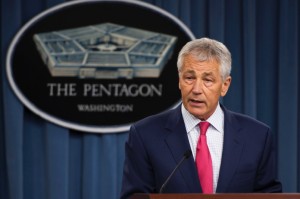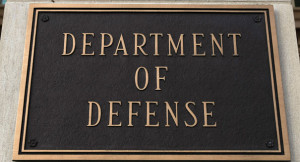redo Jump to...
print Print...

Secretary of Defense Chuck Hagel
(by David Alexander and Andrea Shalal, Reuters) WASHINGTON – The Pentagon said on Monday it would shrink the U.S. Army to pre-World War Two levels, eliminate the popular A-10 aircraft and reduce military benefits in order to meet 2015 spending caps, setting up an election-year fight with the Congress over national defense priorities.
U.S. Defense Secretary Chuck Hagel, discussing the Pentagon’s plan for meeting its new spending caps ahead of the formal budget presentation on March 4, advanced a number of ideas that have been attempted in the past but rejected by Congress or are seen as likely to be unpopular in a congressional election year.
As the United States military winds down its war in Afghanistan and looks to cut billions in defense spending, the Pentagon plans to continue shifting its focus to the Asia-Pacific region and will no longer need a land Army of the size currently planned, Hagel said.
The department plans to reduce the size of the Army to between 440,000 and 450,000 soldiers, he said. The Army is currently about 520,000 soldiers and had been planning to draw down to about 490,000 in the coming year.
A reduction to 450,000 would be the Army’s smallest size since 1940 – before the United States entered World War Two – when it had a troop strength of 267,767, according to Army figures. The Army’s previous post-World War Two low was 479,426 in 1999.
 The planned cut in the Army’s size comes as the Defense Department is in the process of reducing projected spending by nearly a trillion dollars over a 10-year period.
The planned cut in the Army’s size comes as the Defense Department is in the process of reducing projected spending by nearly a trillion dollars over a 10-year period.
A two-year budget deal in Congress in December gave the Pentagon some relief from the budget cuts, but still forced it to reduce spending in the 2014 fiscal year by $30 billion.
The Pentagon’s budget for the 2015 fiscal year is $496 billion, roughly the same as in 2014 but still lower than had envisioned last year.
“This will be the first budget to fully reflect the transition DoD (the Department of Defense) is making after 13 years of war, the longest conflict in our nation’s history,” Hagel said.
“We chose further reductions in troop strength and force structure in every military service – active and reserve – in order to sustain our readiness and technological superiority and to protect critical capabilities,” he said.
A senior U.S. defense official said the approach outlined by Hagel was “pragmatic and responsible,” but noted that “with a smaller force there is less margin for error.”
The official, who spoke on condition of anonymity, warned that a return to deeper budget cuts in 2016 would result in “our forces being too small and out of balance with respect to readiness and modernization.”
Hagel said the Pentagon also planned to eliminate the Air Force’s fleet of A-10 “Warthog” close air support planes, which are much beloved by ground troops, in order to ensure continued funding of the new long-range bomber, the Lockheed Martin F-35 Joint Strike Fighter and a new aerial refueling tanker.
“This was a tough decision,” he said. “But the A-10 is a 40-year-old, single-purpose airplane originally designed to kill enemy tanks on a Cold War battlefield. It cannot survive or operate effectively where there are more advanced aircraft.”
In a reversal of an earlier decision, Hagel said the Pentagon decided to retire the 50-year-old U-2 spy plane in favor of the unmanned Global Hawk system. He said the decision to reverse course came about because the Pentagon had in recent years been able to reduce the Global Hawk’s operating costs.
The Pentagon chief also announced a series of steps to try to reduce the Defense Department’s military and civilian personnel costs, which now make up about half of its spending.
Hagel said the department would slow the growth of tax-free housing allowances, reduce the annual subsidy for military commissaries and reform the TRICARE health insurance program for military family members and retirees.
The defense secretary added that the Pentagon had decided to build only 32 versions of the new Littoral Combat Ship, rather than the 52 envisioned.
(Additional reporting by Phil Stewart; editing by Sandra Maler)
Reprinted here for educational purposes only. May not be reproduced on other websites without permission from Thomson Reuters. Visit the website at Reuters .com.
Questions
1. a) Who is the U.S. Secretary of Defense?
b) What is the role of the Secretary of Defense?
c) What is the purpose of the Pentagon?
2. What spending cuts has the Secretary of Defense proposed for this year? Be specific.
3. How does the Secretary explain his reasoning for the cuts he has determined to make?
4. a) What is significant about the cut in the size of the U.S. Army?
b) What was the population of the U.S. in 1940?
c) What is the population of the U.S. today?
5. a) If you know anyone who is or has been in the military, ask him/her to give an opinion on the cuts in the size of the Army as well as the other cuts the Secretary of Defense is planning to make. Ask them to explain their support for or opposition to the cuts.
b) Ask a parent the same question.
c) Compare these points of view to that of your teacher.
6. Do you think the Pentagon is making cuts in the right areas to cap its spending? Explain your answer.
Background
About the Defense Department:
- The Department of Defense (also known as the Defense Department, DoD or the Pentagon) is the Executive Department of the U.S. government charged with coordinating and supervising all agencies and functions of the government concerned directly with national security and the U.S. armed forces.
- The Department – headed by the Secretary of Defense – has three subordinate military departments: the U.S. Department of the Army, the U.S. Department of the Navy, and the U.S. Department of the Air Force which oversee the U.S. Army,U.S. Navy, U.S. Marine Corps, and the U.S. Air Force. In addition, four national intelligence services are subordinate to DOD – the Defense Intelligence Agency (DIA), the National Security Agency (NSA), the National Geospatial-Intelligence Agency (NGA), and the National Reconnaissance Office (NRO).
- The Secretary of Defense is in the chain of command and exercises command and control, subject only to the orders of the President, over all Department of Defense forces (the Army, Navy, Air Force, and Marine Corps) for both operational and administrative purposes.
- Because the Office of Secretary of Defense is vested with legal powers which exceeds those of any commissioned officer, and is second only to the President in the military hierarchy, it has sometimes unofficially been referred to as a de facto ”deputy commander-in-chief.”
- The Chairman of the Joint Chiefs of Staff is the principal military adviser to the Secretary of Defense and the President, and while the Chairman may assist the Secretary and President in their command functions, the Chairman is not in the chain of command.
- The Secretary of Defense, Secretary of State, the Attorney General and the Secretary of the Treasury, are generally regarded as the four most important cabinet officials because of the importance of their departments.
- The current Secretary of Defense is Chuck Hagel.
- The Pentagon building is the headquarters of the Department of Defense, located in Arlington County, Virginia.
- As a symbol of the U.S. military, “the Pentagon” is often used to refer to the Department of Defense rather than the building itself.
- Where the Department of Defense is charged with military actions abroad, the Department of Homeland Security works in the civilian sphere to protect the United States within, at, and outside its borders. Its stated goal is to prepare for, prevent, and respond to domestic emergencies, particularly terrorism. (from wikipedia)
Daily “Answers” emails are provided for Daily News Articles, Tuesday’s World Events and Friday’s News Quiz.



